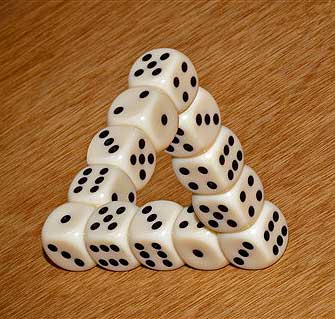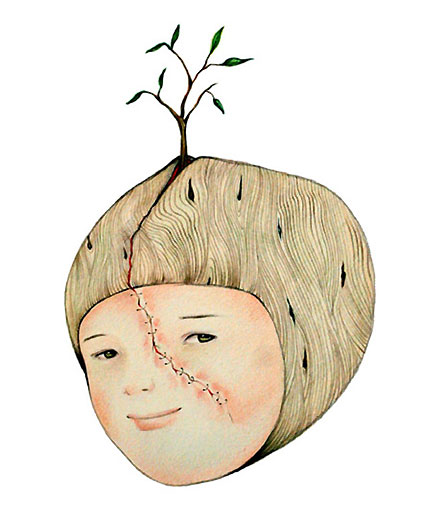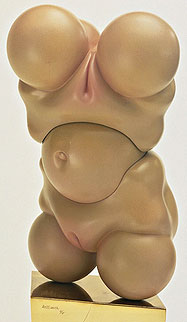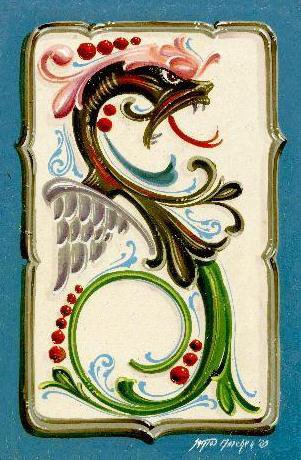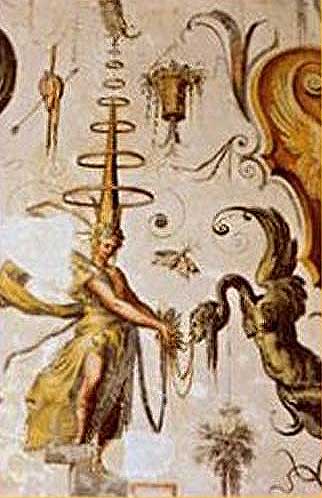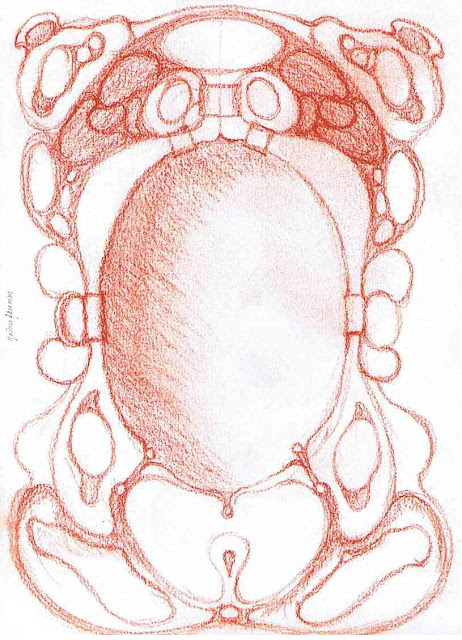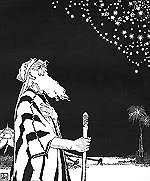The uncanny is the weird, the strange, the mysterious, a mingling of the familiar and the unfamiliar. Even Freud, patron of the uncanny, had trouble defining it. Yet the uncanny is everywhere in contemporary culture.

Louise Bourgeois, Janus fleuri, 1968. Bronze and golden patina, h: 25.7 x w: 31.8 x d: 21.3 cm. Collection of the artist
The Uncanny (German, das Unheimliche—literally, "un-home-ly", but ideomatically, "scary", "creepy") is a Freudian concept of an instance where something can be familiar, yet foreign at the same time, resulting in a feeling of it being uncomfortably strange. Because the uncanny is familiar, yet strange, it often creates cognitive dissonance within the experiencing subject due to the paradoxical nature of being attracted to, yet repulsed by an object at the same time.
Hartmann Schedel, The Monstrous Races: "Blemmyae," from Liber chronicarum (Die Schedelsche Weltchronik, Das Buch der Croniken und Geschichten von Hartmann Schedel), woodcut, 1493
Canny comes from the Anglo-Saxon root ken, "knowledge, understanding, or cognizance." Thus the uncanny is something outside one's familiar knowledge or perceptions.
Robert Gober, Untitled (Leg), 1982-92. Matthew Marks Gallery, New York
Our present day understanding of this notion has been largely shaped by the psychoanalytic viewpoint of Sigmund Freud’s 1919 essay "The Uncanny." There, Freud defines the uncanny experience as "that class of the frightening which leads back to something long known to us, once very familiar." To experience something as "foreign, and yet familiar" may result in feelings of discomfort and alienation. Freud situated "the uncanny" in the realm of the repressed: "[The uncanny] is in reality nothing new or alien, but something which is familiar and old – established in the mind and become alienated from it only through the process of repression." According to the Freudian psychoanalytic model, the process of repression involves the rejection and subsequent suppression of troubling impulses and desires. In his 1919 essay, Freud analyzes the etymology of unheimlich (the German word for "uncanny") and proposes a strong linkage of "the uncanny" to the domestic setting of the home. The German term das Heimlich signifies cosy, that which feels homely, comfortable and familiar. The inversion of this term, das Unheimlich, negates this feeling of comfort and suggests an estrangement or feeling "not at home," literally "unhomely."
Uncanny - Etymology: 1596, "mischievous" (Online Etymology Dictionary)
Uncanny as Fantastic
Notes and references
1. Philip Thomson, The Grotesque, London: Methuen, 1972, 3 Towards a Definition. Thanks to the generosity of its author and David Lavery, this invaluable book can be consulted online. Thomson's discussion and clarifications have paved the way to my own definition of the Grotesque. Thomson approaches the Grotesque from literature and only eventually deals with the visual arts. But his conclusions are perfectly valid to both literature and the visual arts. Targeting the visual arts, my definition is based partly on Thomson's ideas: the Grotesque is a tense and disturbing whole, combining conflicting elements in a visual paradox, which suggests the monstrous (The Grotesque in Francis Bacon's Paintings, 1999; Grotesqueness in the Triptych and Lo Grotesco en las pinturas de Bacon, 2008; see also Ser y No Ser, 2008).
2. Mike Kelley, The Uncanny, Tate Liverpool, 2004
3. Thomson, 4 The Grotesque and Related Terms and Modes
4. Mariano Akerman, Lo familiar vuelto inquietante, Firmamentum, 13.3.2009
Educational aims exclusively. Research and design: Mariano Akerman
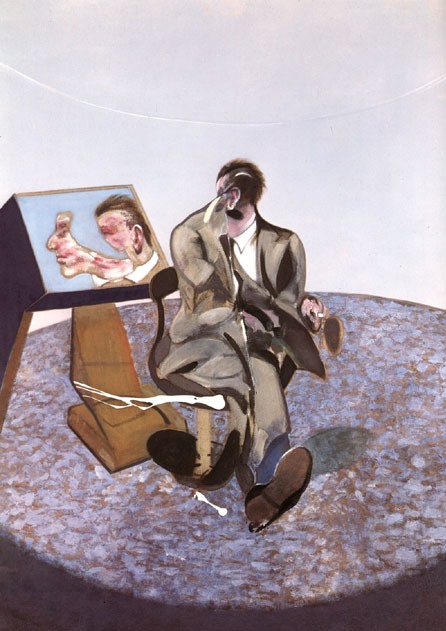
Utterly uncanny? — Mariano Akerman: The Grotesque Bacon's Paintings
Robert Gober, Untitled (Leg), 1982-92. Matthew Marks Gallery, New York
Our present day understanding of this notion has been largely shaped by the psychoanalytic viewpoint of Sigmund Freud’s 1919 essay "The Uncanny." There, Freud defines the uncanny experience as "that class of the frightening which leads back to something long known to us, once very familiar." To experience something as "foreign, and yet familiar" may result in feelings of discomfort and alienation. Freud situated "the uncanny" in the realm of the repressed: "[The uncanny] is in reality nothing new or alien, but something which is familiar and old – established in the mind and become alienated from it only through the process of repression." According to the Freudian psychoanalytic model, the process of repression involves the rejection and subsequent suppression of troubling impulses and desires. In his 1919 essay, Freud analyzes the etymology of unheimlich (the German word for "uncanny") and proposes a strong linkage of "the uncanny" to the domestic setting of the home. The German term das Heimlich signifies cosy, that which feels homely, comfortable and familiar. The inversion of this term, das Unheimlich, negates this feeling of comfort and suggests an estrangement or feeling "not at home," literally "unhomely."
Uncanny - Etymology: 1596, "mischievous" (Online Etymology Dictionary)
Uncanny - Definition: Peculiarly unsettling; eerie; weird; unearthly (American Heritage Dictionary). A literary genre that was coined by Freud when he wrote on Das Unheimliche, which translates literally as the unhomely. The French call it le fantastique. "The canny and the uncanny" are related to one of Freud's psychological theories.
Francis Bacon, Three Studies for Figures at the Base of a Crucifixion (right-hand panel, close-up), 1944. Tate Gallery, London
Francis Bacon, Three Studies for Figures at the Base of a Crucifixion (right-hand panel, close-up), 1944. Tate Gallery, London
Uncanny as Fantastic
"The uncanny" is also a mode of fantastic fiction and is defined in Tzvetan Todorov's Introduction à la littérature fantastique (1970). This author defines the Fantastic, the fantastic uncanny, and the fantastic marvelous. According to him, the fantastic involves any event that happens in our world that seems to be supernatural. Upon the occurrence of the event, one must decide if the event was an illusion or whether it was real and has actually taken place. Todorov uses Alvaro from Cazotte's Le Diable Amoureux as an example of a fantastic event. Alvaro must decide whether the woman he is in love with is truly a woman or if she is the devil. Upon choosing whether the event was real or imaginary, Todorov says that we enter into the genres of uncanny and marvelous. In the fantastic uncanny, the event that occurs is actually an illusion of some sort: the "laws of reality" remain intact and also provide a rational explanation for the fantastic event. Todorov gives examples of dreams, drugs, illusions of the senses, madness, etc. as things that could explain the fantastically uncanny event. In the fantastic marvelous, the supernatural event that occurs has actually taken place and therefore the "laws of reality" must be changed to explain the event. Only when the reader cannot opt for one or the other possibility, the text is purely fantastic (fantastique).
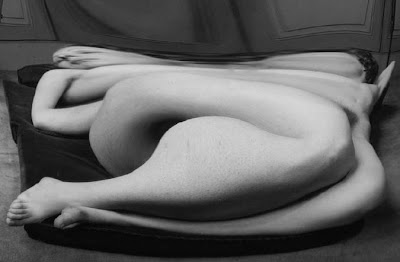
Fantastic uncanny. André Kertész, Distortion, photograph, Paris, 1933

Fantastic uncanny. André Kertész, Distortion, photograph, Paris, 1933
Fantastic marvelous. John Tenniel, illustration for Lewis Carroll’s Alice’s Adventures in Wonderland, engraving, 1869
Purely fantastic. Hand, c. 2007. Todorov's fantastique is no doubt compatible with the notion of the grotesque understood as "the unresolved clash of incompatibles in work and response" and/or "the ambivalently abnormal" (Thomson, 1972).[1]
Yuka Yamaguchi, A New Seedling, color pencil and ballpoint pen, 2008 (The Cute and the Creepy).
Uncanny Grotesqueness
Hans Bellmer, Doll, 1936 (cast in 1965). Painted aluminum on bronze base, 66 x 25.4 x 27.9 cm. Zwirner & Wirth, New York; The Museum of Modern Art, New York
Mike Kelley on the Uncanny. Everyone knows how the human body is organized; this is a given and is never thought about. To become aware of these particulars, one must imagine oneself unwhole, cut into parts, deformed or dead. [...] In recent art, the modernist notion of the fragment as a microcosm has given way to a willingness to let fragments be fragments, to allow partiality to exist [as such]. [...] The Surrealist artist, Hans Bellmer, constructed a life-size figure of a young girl in the early 1930s. This figure was fully jointed and came apart in pieces in such a way that it could be put back together in innumerable ways. He also made extra pieces that could be added so that the figure could have, if desired, multiples of some parts. The 'doll' is a perfect illustration of Bellmer's notion of the body as anagram: the body as a kind of sentence that can be scrambled again and again to produce new meanings every time.
...
The uncanny is apprehended as a physical sensation, like the one I have always associated with an "art" experience – especially when we interact with an object or a film. This sensation is tied to the act of remembering. I can still recall, as everyone can, certain strong, uncanny, aesthetic experiences I had as a child.
Such past feelings (which recur even now in my recollection of them) seem to have been provoked by disturbing, unrecallable memories. They were provoked by a confrontation between "me" and an "it" that was highly charged, so much so that "me" and "it" become confused.
The uncanny is a somewhat muted sense of horror: horror tinged with confusion. It produces ‘goose bumps’ and is ‘spine tingling’. It also seems related to déjà vu, the feeling of having experienced something before, the particulars of that previous experience being unrecallable, except as an atmosphere that was ‘creepy’ or ‘weird’. But if it was such a loaded situation, so important, why can the experience not be remembered? These feelings seem related to so-called out-of-body experiences, where you become so bodily aware that you have the sense of watching yourself from outside yourself. All of these feelings are provoked by an object, a dead object that has a life of its own, a life that is somehow dependent on you, and is intimately connected in some secret manner to your life.
In his essay The Uncanny (1919), Freud writes about how the uncanny is associated with the bringing to light of what was hidden and secret, distinguishing the uncanny from the simply fearful by defining it as "that class of the terrifying which leads us back to something long known to us, once very familiar." In the same essay, Freud cites Ernst Jentsch, who located the uncanny in "doubts" about "whether an apparently animate being is really alive; or conversely, whether a lifeless object might not in fact be animate."[2]
Purely fantastic. Hand, c. 2007. Todorov's fantastique is no doubt compatible with the notion of the grotesque understood as "the unresolved clash of incompatibles in work and response" and/or "the ambivalently abnormal" (Thomson, 1972).[1]
Yuka Yamaguchi, A New Seedling, color pencil and ballpoint pen, 2008 (The Cute and the Creepy).
Uncanny Grotesqueness
Hans Bellmer, Doll, 1936 (cast in 1965). Painted aluminum on bronze base, 66 x 25.4 x 27.9 cm. Zwirner & Wirth, New York; The Museum of Modern Art, New York
Mike Kelley on the Uncanny. Everyone knows how the human body is organized; this is a given and is never thought about. To become aware of these particulars, one must imagine oneself unwhole, cut into parts, deformed or dead. [...] In recent art, the modernist notion of the fragment as a microcosm has given way to a willingness to let fragments be fragments, to allow partiality to exist [as such]. [...] The Surrealist artist, Hans Bellmer, constructed a life-size figure of a young girl in the early 1930s. This figure was fully jointed and came apart in pieces in such a way that it could be put back together in innumerable ways. He also made extra pieces that could be added so that the figure could have, if desired, multiples of some parts. The 'doll' is a perfect illustration of Bellmer's notion of the body as anagram: the body as a kind of sentence that can be scrambled again and again to produce new meanings every time.
...
The uncanny is apprehended as a physical sensation, like the one I have always associated with an "art" experience – especially when we interact with an object or a film. This sensation is tied to the act of remembering. I can still recall, as everyone can, certain strong, uncanny, aesthetic experiences I had as a child.
Such past feelings (which recur even now in my recollection of them) seem to have been provoked by disturbing, unrecallable memories. They were provoked by a confrontation between "me" and an "it" that was highly charged, so much so that "me" and "it" become confused.
The uncanny is a somewhat muted sense of horror: horror tinged with confusion. It produces ‘goose bumps’ and is ‘spine tingling’. It also seems related to déjà vu, the feeling of having experienced something before, the particulars of that previous experience being unrecallable, except as an atmosphere that was ‘creepy’ or ‘weird’. But if it was such a loaded situation, so important, why can the experience not be remembered? These feelings seem related to so-called out-of-body experiences, where you become so bodily aware that you have the sense of watching yourself from outside yourself. All of these feelings are provoked by an object, a dead object that has a life of its own, a life that is somehow dependent on you, and is intimately connected in some secret manner to your life.
In his essay The Uncanny (1919), Freud writes about how the uncanny is associated with the bringing to light of what was hidden and secret, distinguishing the uncanny from the simply fearful by defining it as "that class of the terrifying which leads us back to something long known to us, once very familiar." In the same essay, Freud cites Ernst Jentsch, who located the uncanny in "doubts" about "whether an apparently animate being is really alive; or conversely, whether a lifeless object might not in fact be animate."[2]
Robert Mapplethorpe, Louise Bourgeois, silver gelatin print, 1982. The latex and plaster sculpture the artist holds under her arm as if it were as a loaf of French bread is known as "Fillette."
Bizarre and Grotesque. The difference between the bizarre and the grotesque is mainly one of degree. The grotesque is more radical and usually more aggressive. Kayser expresses the difference by calling the grotesque more dangerous: the bizarre, he points out, can be used synonymously with 'very strange', 'outlandish'—it lacks the disturbing quality of the grotesque. Here one again of course runs into the problem of subjectivity: what is grotesque to one person may be only bizarre to another. [...] Of course, the dividing line may in any case be very difficult to draw, and one can point to a number of works where the bizarre turns into the grotesque for a brief moment. We can describe this process in technical terms in the following way: something which is very strange, and perhaps ludicrous as well, is made so exceedingly abnormal that our laughter at the ludicrous and eccentric is intruded on by feelings of horror or disgust; or, a scene or character which is laughably eccentric suddenly becomes problematic, and our reaction to it mixed, through the appearance of something quite at odds with the comic (Thomson).[3]
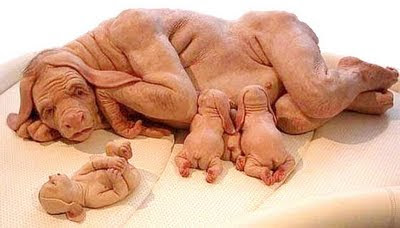
Patricia Piccinini, The Young Family, sculpture, 2002
Double-edged 1. Having two edges that can be used; having two cutting edges. 2 Having a dual purpose; having two meanings; effective or capable of being interpreted in two ways. Double-edged sword - literally, a sword which cuts on either side; metaphorically, an argument which makes both for and against the person employing it, or which has a double meaning.
Bizarre and Grotesque. The difference between the bizarre and the grotesque is mainly one of degree. The grotesque is more radical and usually more aggressive. Kayser expresses the difference by calling the grotesque more dangerous: the bizarre, he points out, can be used synonymously with 'very strange', 'outlandish'—it lacks the disturbing quality of the grotesque. Here one again of course runs into the problem of subjectivity: what is grotesque to one person may be only bizarre to another. [...] Of course, the dividing line may in any case be very difficult to draw, and one can point to a number of works where the bizarre turns into the grotesque for a brief moment. We can describe this process in technical terms in the following way: something which is very strange, and perhaps ludicrous as well, is made so exceedingly abnormal that our laughter at the ludicrous and eccentric is intruded on by feelings of horror or disgust; or, a scene or character which is laughably eccentric suddenly becomes problematic, and our reaction to it mixed, through the appearance of something quite at odds with the comic (Thomson).[3]

Patricia Piccinini, The Young Family, sculpture, 2002
Double-edged 1. Having two edges that can be used; having two cutting edges. 2 Having a dual purpose; having two meanings; effective or capable of being interpreted in two ways. Double-edged sword - literally, a sword which cuts on either side; metaphorically, an argument which makes both for and against the person employing it, or which has a double meaning.
Mariano Akerman, De doble filo (Doube-edged), April 2008. As Ruskin aptly observes in The Stones of Venice (1853), the Grotesque involves two components. One of them is amusing; the other frightening. Them both coexist in a single whole, which by definition is paradoxical one.

Francis Bacon, Figure with Meat (Head surrounded by Sides of Beef), 1954, oil on canvas, 129.9 cm × 121.9 cm. Art Institute of Chicago
Both Freud's Unheimliche and Todorov's fantastique have a lot to do with Thomson's conceptualization of the Grotesque. Landmark of the Uncanny, Franz Kafka's Metamorphosis (Die Verwandlung, 1915) in turn fits Freud's Unheimliche, Todorov's fantastique, and Thomson's definitions of the Grotesque.

Roberto Aizenberg, Painting, 1985. Oil on canvas, 86 x 57 cm. Museo Nacional de Bellas Artes, Buenos Aires
"When Gregor Samsa awoke one morning from uneasy dreams he found himself transformed in his bed into a gigantic insect," writes Kafka. But all along the story, Kafka's most peculiar insect also expresses human feelings and thoughts. Uncannily, the protagonist's look is that of an insect, but one which has simultaneously retained the very worries, logic, needs, nostalgy, preoccupations, hopes and sentiments of Gregor Samsa himself.
Thus, Kafka's protagonist is a double-edged entity that simultaneously fits different concepts pertaining to different domains: psychoanalysis (das Unheimliche), literature (le fantastique), and fine arts (The Grotesque). Besides, it also fits Schelling's initial idea of the familiar turned into unsettling.[4]

Francis Bacon, Figure with Meat (Head surrounded by Sides of Beef), 1954, oil on canvas, 129.9 cm × 121.9 cm. Art Institute of Chicago
Both Freud's Unheimliche and Todorov's fantastique have a lot to do with Thomson's conceptualization of the Grotesque. Landmark of the Uncanny, Franz Kafka's Metamorphosis (Die Verwandlung, 1915) in turn fits Freud's Unheimliche, Todorov's fantastique, and Thomson's definitions of the Grotesque.

Roberto Aizenberg, Painting, 1985. Oil on canvas, 86 x 57 cm. Museo Nacional de Bellas Artes, Buenos Aires
"When Gregor Samsa awoke one morning from uneasy dreams he found himself transformed in his bed into a gigantic insect," writes Kafka. But all along the story, Kafka's most peculiar insect also expresses human feelings and thoughts. Uncannily, the protagonist's look is that of an insect, but one which has simultaneously retained the very worries, logic, needs, nostalgy, preoccupations, hopes and sentiments of Gregor Samsa himself.
Thus, Kafka's protagonist is a double-edged entity that simultaneously fits different concepts pertaining to different domains: psychoanalysis (das Unheimliche), literature (le fantastique), and fine arts (The Grotesque). Besides, it also fits Schelling's initial idea of the familiar turned into unsettling.[4]
Notes and references
1. Philip Thomson, The Grotesque, London: Methuen, 1972, 3 Towards a Definition. Thanks to the generosity of its author and David Lavery, this invaluable book can be consulted online. Thomson's discussion and clarifications have paved the way to my own definition of the Grotesque. Thomson approaches the Grotesque from literature and only eventually deals with the visual arts. But his conclusions are perfectly valid to both literature and the visual arts. Targeting the visual arts, my definition is based partly on Thomson's ideas: the Grotesque is a tense and disturbing whole, combining conflicting elements in a visual paradox, which suggests the monstrous (The Grotesque in Francis Bacon's Paintings, 1999; Grotesqueness in the Triptych and Lo Grotesco en las pinturas de Bacon, 2008; see also Ser y No Ser, 2008).
2. Mike Kelley, The Uncanny, Tate Liverpool, 2004
3. Thomson, 4 The Grotesque and Related Terms and Modes
4. Mariano Akerman, Lo familiar vuelto inquietante, Firmamentum, 13.3.2009
Educational aims exclusively. Research and design: Mariano Akerman

Utterly uncanny? — Mariano Akerman: The Grotesque Bacon's Paintings





